What Are the 5 Koppen Climate Classification Types?
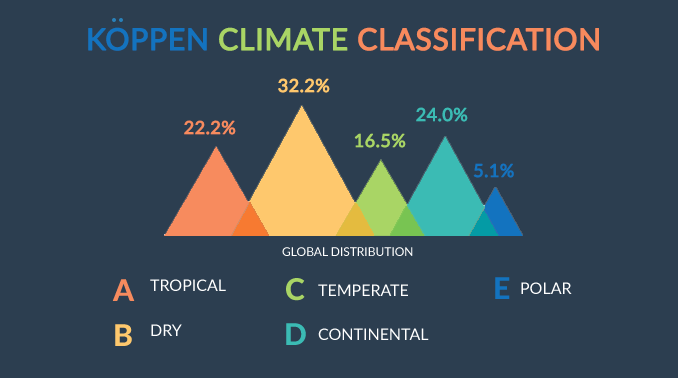
“The Koppen climate classification is the most widely used system to catalog climate types in the world.”
The Koppen climate classification was developed by Wladimir Koppen more than a century ago. Because Koppen was a botanist, he heavily tied climate to vegetation. He also experimented with weather balloons to plot seasonal temperature ranges.
In the eyes of Koppen, the world consists of 5 climate types:
- TROPICAL OR MEGATHERMAL CLIMATES (A): Tropical or megathermal climates are characterized as having constant warm temperatures.
- DRY OR ARID CLIMATES (B): Dry or arid climates have low precipitation rates.
- TEMPERATE OR MESOTHERMAL CLIMATES (C): Temperate or mesothermal climates maintain mild annual temperatures.
- CONTINENTAL OR MICROTHERMAL CLIMATES (D): Continental or microthermal climates have hot summers and cold winters occurring typically at the interior of a continent.
- POLAR OR ALPINE CLIMATES (E) Polar or alpine climates sustain consistent cold temperatures throughout the year.
These classifications can be divided into finer units. So let’s go through each class and explore where you fit the criteria.
1. Tropical (A)
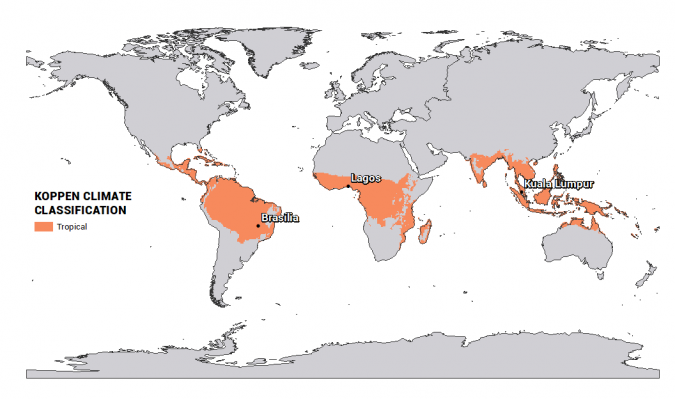
It’s warm all year round for tropical climates. You can typically find this type of climate near the equator from 15°N to 15°S latitude.
For example, tropical rainforests are hot, moist regions easily distinguishable by their enormous trees, diverse species and thick soils.
Tropical climates sustain a healthy portion of high temperature (+18°C) with its lowest mean monthly air temperature greater than 18 °C.
And you can divide tropical climates further by their amount of precipitations:
| Climate Type | Criteria |
| Tropical (A) | The lowest mean monthly temperature is greater than 18°C. |
| Tropical rainforest (Af) | Precipitation in the driest month is at least 6 cm or greater. |
| Tropical monsoon (Am) | Precipitation in the driest month is less than 6 cm but more than 4% of total annual precipitation. |
| Tropical wet and dry savannah (Aw) | Precipitation in the driest month is less than 10 cm and less than 4% of total annual precipitation. |
2. Dry (B)
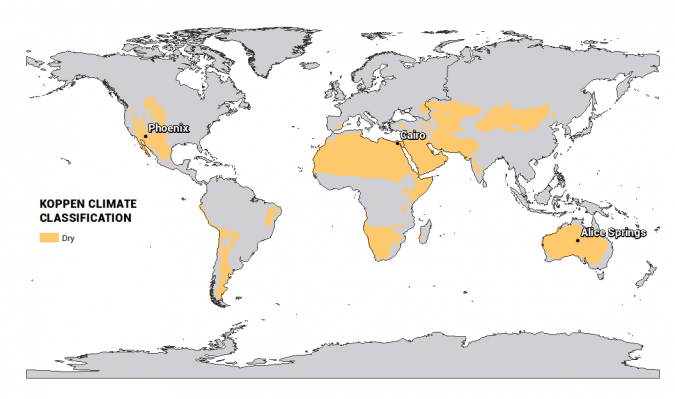
Dry climates are the only category in the Koppen climate classification that isn’t entirely based on temperature. They are characterized by having a shortage of water with a low annual mean precipitation rate because water evaporates quickly from its temperatures.
In order to classify dry climates, you calculate the precipitation threshold based on how much total precipitation falls during the high sun period. In the northern hemisphere, the defined period is from April to September. But in the southern hemisphere, it’s from October through March.
If the annual precipitation is less than 50% of the precipitation threshold, the classification is BW (arid: desert climate). But if it is more than 50%, the Koppen climate classification is BS (semi-arid: steppe climate). For example, Phoenix, Arizona has an average annual temperature of 21.8°C. Approximately 38.4% of its annual precipitation falls from April to September. Because its precipitation threshold is less than 50%, Phoenix, Arizona is an arid desert climate.
| Climate Type | Criteria |
| Arid desert (BW) | Annual precipitation is less than 50% of the precipitation threshold. |
| Semi-arid steppe (BS) | Annual precipitation is more than 50% of the precipitation threshold. |
3. Temperate (C)
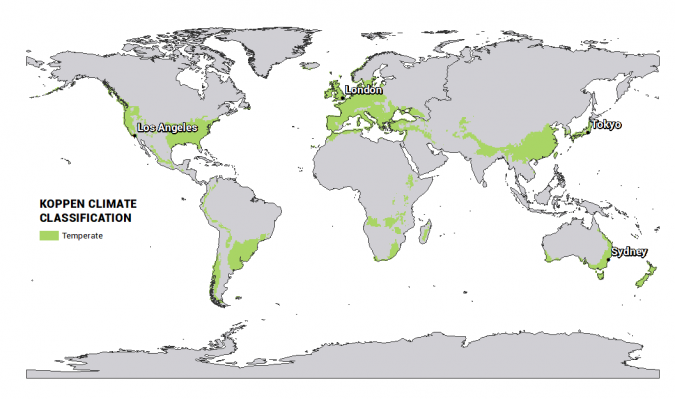
Temperate climate types take the middle road for average temperature. These types of climates are common along the edge of continents.
For example, coastal locations have moderate changes in temperature with mild winters and summers. Seasonal changes aren’t as extreme as dry climates.
If the average temperature of the warmest month is higher than 10°C and the coldest month is between 18° and 0°C, then it’s considered a temperature climate.
You can add a second letter that describes precipitation patterns:
| Climate Type | Criteria |
| Mild temperate dry summer (Cs) | Precipitation in the driest month of summer is less than 1/3 the amount in the wettest winter month. |
| Mild temperate dry winter (Cw) | Precipitation in the driest month of winter is less than 1/10 of the amount in the wettest summer month. |
| Mild temperate humid (Cf) | Does not satisfy Cs or Cw climate types. |
4. Continental (D)
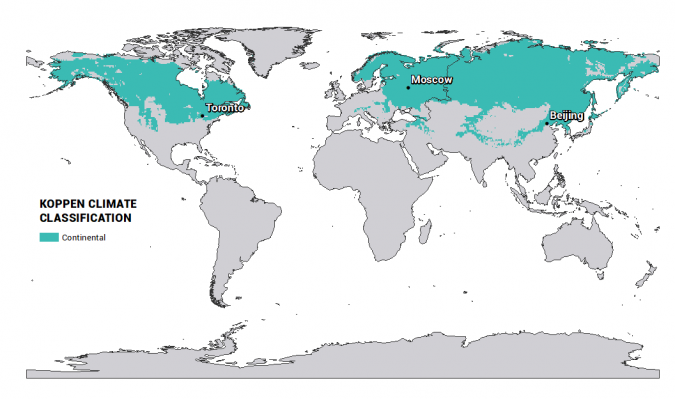
Continental climates are usually situated in the interior of continents. They have at least one month with an average temperature below 0°C. Likewise, at least one-month averages above 10 °C.
When you combine continental and dry climate types, they take up a large portion (approximately 56%) of the surface. It also experiences drastic shifts during seasonal changes.
Typically, continental climates range from 40° to 75° latitudes in the northern and southern hemispheres. However, this type of climate type is rare in the southern hemisphere.
| Climate Type | Criteria |
| Continental dry summer (Ds) | Precipitation in the driest month of summer is less than 1/3 the amount in the wettest winter month. |
| Continental dry winter (Dw) | Precipitation in the driest month of winter is less than 1/10 of the amount in the wettest summer month. |
| Continental humid (Df) | Does not satisfy Ds or Dw climate types. |
5. Polar (E)

Lastly, polar climates endure frigid temperatures year-round. The average temperature of the warmest month in polar climatic zones is below 10°C.
Typically, these types of climates occur in the polar regions, generally greater than 70° latitude in the northern and southern hemispheres.
Very little vegetation grows in polar types climates because it’s above the tree line. Most icecap type of climates belong to Inner Greenland and Antarctica.
| Climate Type | Criteria |
| Tundra (ET) | The average temperature in the warmest month is between 10° and 0°C. |
| Ice Cap (EF) | The average temperature of the warmest month is 0°C or below. |
What’s the importance of defining climate systems?
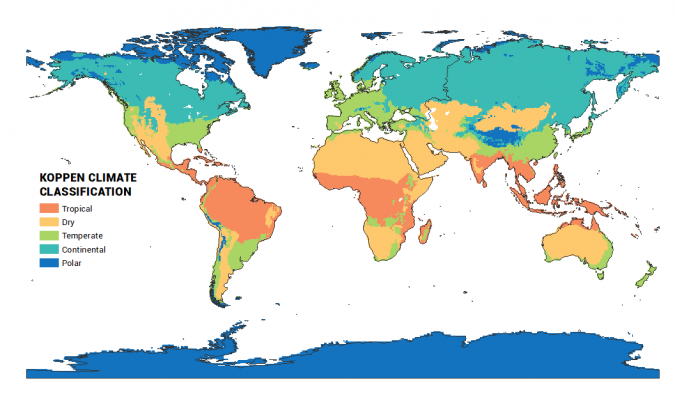
As climate change becomes a reality, it’s becoming more necessary to document and catalog climate types around the world.
How is the climate changing? What was the climate a decade ago? Only when we can map the world with the Koppen climate classification system we can answer these crucial questions.
Do you have any questions about the Koppen climate classification system?


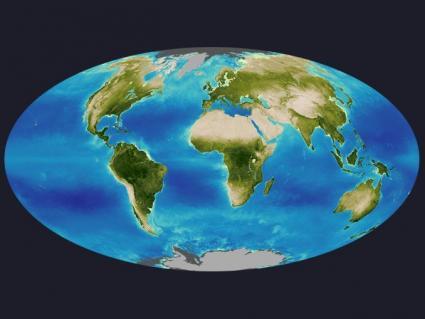


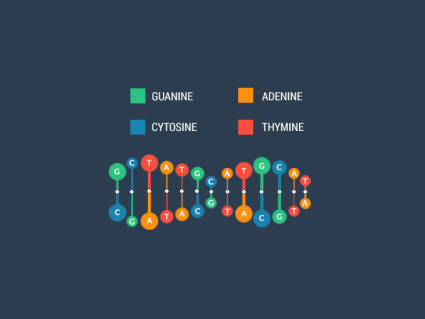
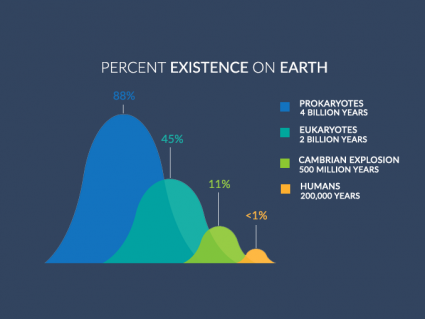

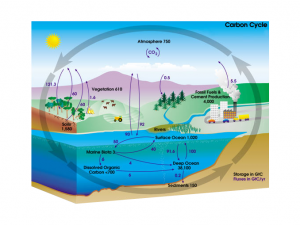


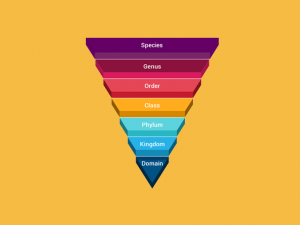
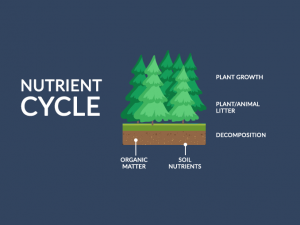


It’s really interesting how Koppen’s classification explains everything about climate.
It gave me a real nice understanding of Koppen’s classification criteria of climate
Pretty interesting.
Is there is an algorithm to determine climate type based on coordinates? Thanks.
Let’s start by noting the difference between weather and climate:
In most places, weather can change from minute-to-minute, hour-to-hour, day-to-day, and season-to-season. Climate, however, is the average of weather over time and space.
The IPCC defines the time period for climate as the average measured over 30 years. Accurate global measurements have only existed since satellite measurements began in the 1970’s. That’s about 2 dots on the global climate graph…
I really don’t have any questions for now. It is fascinating though.